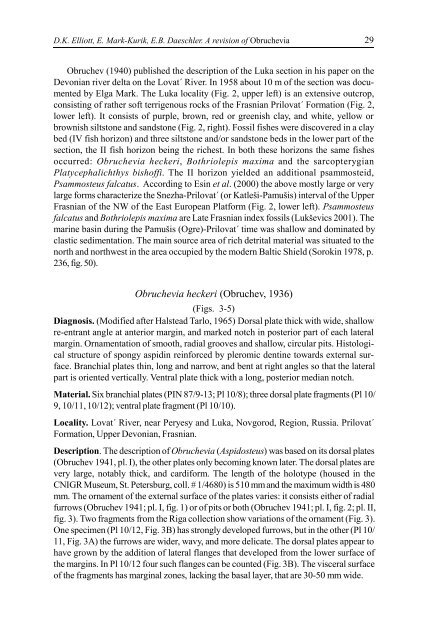Zemes un vides zinātnes Earth and Environment Sciences - Latvijas ...
Zemes un vides zinātnes Earth and Environment Sciences - Latvijas ...
Zemes un vides zinātnes Earth and Environment Sciences - Latvijas ...
Create successful ePaper yourself
Turn your PDF publications into a flip-book with our unique Google optimized e-Paper software.
D.K. Elliott, E. Mark-Kurik, E.B. Daeschler. A revision of Obruchevia<br />
29<br />
Obruchev (1940) published the description of the Luka section in his paper on the<br />
Devonian river delta on the Lovat´ River. In 1958 about 10 m of the section was documented<br />
by Elga Mark. The Luka locality (Fig. 2, upper left) is an extensive outcrop,<br />
consisting of rather soft terrigenous rocks of the Frasnian Prilovat´ Formation (Fig. 2,<br />
lower left). It consists of purple, brown, red or greenish clay, <strong>and</strong> white, yellow or<br />
brownish siltstone <strong>and</strong> s<strong>and</strong>stone (Fig. 2, right). Fossil fishes were discovered in a clay<br />
bed (IV fish horizon) <strong>and</strong> three siltstone <strong>and</strong>/or s<strong>and</strong>stone beds in the lower part of the<br />
section, the II fish horizon being the richest. In both these horizons the same fishes<br />
occurred: Obruchevia heckeri, Bothriolepis maxima <strong>and</strong> the sarcopterygian<br />
Platycephalichthys bishoffi. The II horizon yielded an additional psammosteid,<br />
Psammosteus falcatus. According to Esin et al. (2000) the above mostly large or very<br />
large forms characterize the Snezha-Prilovat´ (or Katleši-Pamušis) interval of the Upper<br />
Frasnian of the NW of the East European Platform (Fig. 2, lower left). Psammosteus<br />
falcatus <strong>and</strong> Bothriolepis maxima are Late Frasnian index fossils (Lukševics 2001). The<br />
marine basin during the Pamušis (Ogre)-Prilovat´ time was shallow <strong>and</strong> dominated by<br />
clastic sedimentation. The main source area of rich detrital material was situated to the<br />
north <strong>and</strong> northwest in the area occupied by the modern Baltic Shield (Sorokin 1978, p.<br />
236, fig. 50).<br />
Obruchevia heckeri (Obruchev, 1936)<br />
(Figs. 3-5)<br />
Diagnosis. (Modified after Halstead Tarlo, 1965) Dorsal plate thick with wide, shallow<br />
re-entrant angle at anterior margin, <strong>and</strong> marked notch in posterior part of each lateral<br />
margin. Ornamentation of smooth, radial grooves <strong>and</strong> shallow, circular pits. Histological<br />
structure of spongy aspidin reinforced by pleromic dentine towards external surface.<br />
Branchial plates thin, long <strong>and</strong> narrow, <strong>and</strong> bent at right angles so that the lateral<br />
part is oriented vertically. Ventral plate thick with a long, posterior median notch.<br />
Material. Six branchial plates (PIN 87/9-13; Pl 10/8); three dorsal plate fragments (Pl 10/<br />
9, 10/11, 10/12); ventral plate fragment (Pl 10/10).<br />
Locality. Lovat´ River, near Peryesy <strong>and</strong> Luka, Novgorod, Region, Russia. Prilovat´<br />
Formation, Upper Devonian, Frasnian.<br />
Description. The description of Obruchevia (Aspidosteus) was based on its dorsal plates<br />
(Obruchev 1941, pl. I), the other plates only becoming known later. The dorsal plates are<br />
very large, notably thick, <strong>and</strong> cardiform. The length of the holotype (housed in the<br />
CNIGR Museum, St. Petersburg, coll. # 1/4680) is 510 mm <strong>and</strong> the maximum width is 480<br />
mm. The ornament of the external surface of the plates varies: it consists either of radial<br />
furrows (Obruchev 1941; pl. I, fig. 1) or of pits or both (Obruchev 1941; pl. I, fig. 2; pl. II,<br />
fig. 3). Two fragments from the Riga collection show variations of the ornament (Fig. 3).<br />
One specimen (Pl 10/12, Fig. 3B) has strongly developed furrows, but in the other (Pl 10/<br />
11, Fig. 3A) the furrows are wider, wavy, <strong>and</strong> more delicate. The dorsal plates appear to<br />
have grown by the addition of lateral flanges that developed from the lower surface of<br />
the margins. In Pl 10/12 four such flanges can be co<strong>un</strong>ted (Fig. 3B). The visceral surface<br />
of the fragments has marginal zones, lacking the basal layer, that are 30-50 mm wide.
















